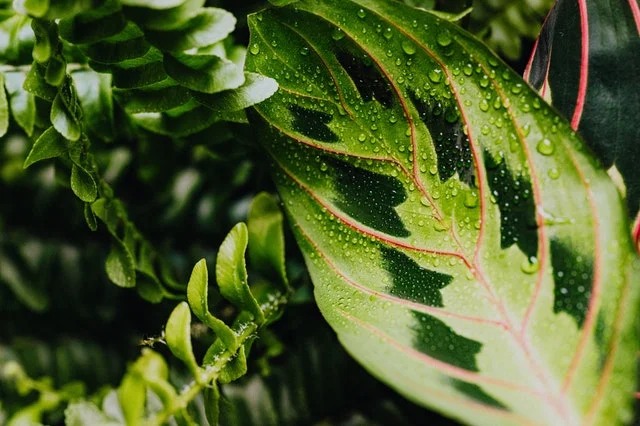The calathea rufibarba is a flowering plant, also called the furry feather calathea. It received this name because of the unusual furry underside of its leaves. This species is native to Brazil but makes a beautiful houseplant.
The smooth, long, deep green leaves with the velvety maroon undersides are pieces of art and make wonderful decor for homes and offices.
Table of Contents
Calathea Rufibarba Care
With the optimal care provisions, the foliage can grow up to a meter tall. The size makes it suitable for a variety of spaces.
The type of care required might be considered a little fussy in terms of some aspects, but it isn’t as prone to being overwatered as are some kinds of plants.
Also, once a person understands its necessary level of care and is willing to provide it, the routine is simple.
What does your calathea rufibarba require?
The species of plant has some essential requirements to fulfill. These are the minimal components that allow the foliage to be healthy.
Light Requirements
The calathea rufibarba plant requires a lot of diffused light. They can survive in low-lit areas to some degree, but better lighting means a healthier plant. That said, direct sunlight may make the leaf color fade.
Sometimes experimenting with placement in the home or office is required to find the best location.
Temperature Requirements
The optimal temperatures range between 18-23 degrees Celsius (64-73 degrees Fahrenheit). The plants can tolerate temperatures as low as 15 degrees Celsius (59 degrees Fahrenheit).
They cannot tolerate droughts, and the air should be well-ventilated.
Humidity Requirements
The plant requires high humidity levels. Placing the pot on a wet pebble tray can help with this, as does misting the area. An air humidifier may be necessary for drier air conditions.
Water Requirements
The best watering practice for the furry feather calathea is applying it often but in small amounts. The soil must be kept moist at all times, but the roots cannot be sitting in water.
If the leaves start to turn yellow, the plant is probably being overwatered. If the leaves start to curl, it isn’t getting enough water. This can be prevented by spraying the plant twice a day.
Soil Requirements
Similar to other tropical plants, it prefers a well-draining potting mix. A standard mix works well as long as it can drain properly and is placed in a pot or container with an adequate drainage system.
Fertilizer Requirements
Nitrogen-rich fertilizer can be added to the soil once or twice per month during the growing season. It is not required during the winter months.
Extra Tips For Calathea Rufibarba
This species of plant can be easily cared for. Other than needing enough water and light without too much of them, they can thrive.
That said, certain details concerning insects, illnesses, pruning, and propagation are essential to the correct care as well. Here are some extra tips regarding those topics.
Pests and Diseases
Because of the required moisture levels, there are sometimes issues with insects and certain illnesses. There are prevention methods, including wiping down the leaves and using neem oil as a deterrent. Here are the main issues that may arise.
With any treatment noted here, damaged areas of the plant must be removed to help the plant become healthy again.
- Mealybugs: These pale-colored segmented insects love to feed off the stems and leaves of calathea rufibarba plants, creating yellow or brown discoloration of the affected areas. They create a wax or cotton-like substance that a caregiver may see left on the plant or around the soil’s surface near the stalk. Mealybugs can be killed immediately by dabbing each one with rubbing alcohol. Larger infestations may require insecticides or insecticidal soap.
- Scale Insects: Scale insects look like little bumps on the leaves. These pests cause damage to the areas where they feed. The infestations require treatment as soon as they are discovered. This process can be done using insecticides.
- Spider Mites: These small black, red, or white arachnids leave their dusty webs on the foliage. The creatures can also be seen at times upon inspecting the plant. Insecticides may be applied to eliminate any infestations.
- Thrips: The small, slim, winged creatures can be prevented by regularly pruning the calathea rufibarba. This action is partly how they are treated as well. It is often recommended to trim leaves where thrips are found and treat the plant with neem oil or other insecticides.
- Root Rot: The initial signs of the fungal disease are discoloring of the leaves and stem, as well as these areas turning soft and mushy. Damaged areas must be removed. A fungicide may be required. In most cases, repotting into fresh soil in a new pot is advised.
Pruning
Pruning the calathea rufibarba plant should be done using sterilized sharp scissors or pruning shears.
The leaves can be cut as required. The cutting will cause the plant to focus its growth in this area, repairing damaged areas or creating additional greenery. Any cutting needs to be completed near steam, such as from a humidifier.
Leaves may be completely removed and should be if they are damaged. However, a caregiver can also choose to trim off crispy edges, keeping the rest of the leaf intact.
How To Propagate Calathea
Propagating this species is a different process than what is used for pruning. This procedure is often utilized for plants that are becoming too big for the space involved. Such a process means a person will have more than one plant and can opt to keep it or give it as a gift.
Propagating calathea rufibarba works best when it is through root separation. A caregiver must take the plant out of the soil and lightly shake off the potting mix. When the soil is mostly removed, the divisions become visible.
The caregiver must select the shoots that are more readily separated to prevent possible damage.
The roots should be able to be gently pulled away. Once that is done, it can be placed in a separate plant pot filled with the same potting mix as its mother.
Toxicity
Calathea rufibarba plants are non-toxic to humans and animals.
Photo by Karolina Grabowska from Pexels



